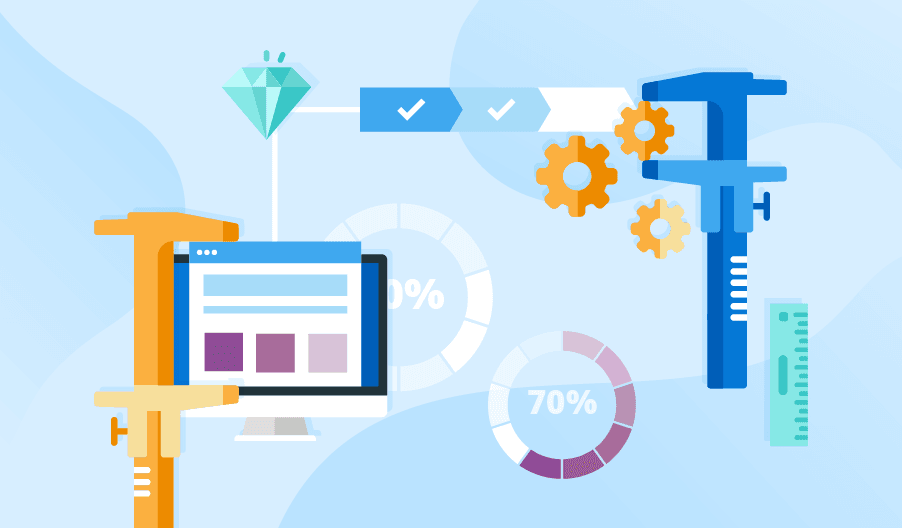Scroll down for more
Top Software Development Metrics for Tracking Project Success
The efficiency with which your software development team works is critical for product development and business growth. Thus, it is vital to use the right software development metrics and measurements to estimate the results of the development team and figure out ways to improve the work process.
Let’s look at the software development metrics that companies use most frequently and find out why and how to use them.
1. What is a software development metric?
Software development metrics are a set of attributes that are calculated to determine whether the team's goals are being met during the software development process. These metrics will help find problems with the development. Whether the results are positive or negative, they will assist the group in improving the overall improvement process.
The team will be given more praise when the results are good, which will motivate them to perform even better. On the other hand, if the outcomes are negative, it will inspire the development team to address the issues as soon as possible to improve the process.

2. What are the benefits of measuring software development metrics
The goal behind using precise software development metrics is to identify and control what can affect software development and the project as a whole. Specifically, using software development metrics contributes to the following:
Helping to plan, prioritize, and predict
Project managers and team leads can obtain more insights into the project and predict the possible outcomes using software development metrics. For example, you can estimate:
- Estimate the costs in three main phases: collecting requirements, designing the system, and deployment. This way, you can understand the contribution of each activity to the total project cost and establish better priorities.
- Estimate how frequently and concisely you are delivering new units; assess the effects of new practices or changes, and set targets for process and product improvements.
You can measure the time it takes to conduct each major development activity and estimate its effect on quality and productivity. Afterwards, you can compare the costs and benefits of certain practices to determine which is worth the cost. Or you can benchmark two different practices to choose a better approach: for example, ask two teams to test different DevOps practices and determine which increases code quality.
Improved Software Developers’ Performance
Productivity metrics in software development clarify performance expectations. Your team remains engaged as they know exactly what is expected of them at work. Metrics communicate your expectations and show you how to measure developer productivity without bias.
Productivity metrics for software development help you identify what factors hinder the effectiveness of your team and eliminate those, which would ultimately lead to a happier, high-performing team.

3. What are the types of software development metrics during the development phase?
Considering that fact, here are the foremost software development metrics that should be analyzed to boost the overall software development process:
Work in Progress: Work in Progress is the software development metric that the team has begun working on but is no longer in the pipeline, as the name suggests. Software development teams will see the amount of work completed and/or pending. Additionally, it will assist the group in better task management and the timely achievement of objectives.
Sprint Burndown: Sprint burndown is one of the best KPIs for software development metrics because it displays the remaining time to accomplish an earlier planned task. Tasks in software development are divided, and they should be completed within the given timeframe.
Sprint burndown will help in determining the remaining time, which can be used by the development team to determine whether they can complete the sprint within the deadline or not. If the sprint burndown shows that the task cannot be completed by the deadline, then it is crucial to amend the process, and identify the vulnerabilities that led to the delay.
Not only does sprint burndown help track the overall progress of the development process, but it also notifies the team about the hurdles in the process and lets them know if they can meet the set target or not.
Release Burndown: Release progress is another important software development metric that is measured by release burndown. This software development KPI identifies whether the team can release the final software within the specified deadline or not. Through this KPI, the developers can know how their team handles the backlog, and predict the sprint numbers that should be completed and the release date of the software as well.
Release burndown is also a graph that displays data visually. There are X and Y axes that show the sprints and story points, respectively. By analyzing the visual representation of the release burndown, the development team can determine the expected finish date of the project.
Velocity: Velocity is among the foremost KPIs for software development, and it is preferred by experienced developers to analyze the work that can be accomplished by the development team within the given time or sprint. The primary reason why this metric is preferred by developers is its assistance in planning future sprints as well as forecasting the number of iterations that may be required by a project. Velocity is measured in either story points or hours.
Cycle Time: Cycle time is the time spent by the development team while working on a task. By calculating this agile software development KPI, you can analyze the efficacy of your team in the software development process. Furthermore, it will allow you to foresee the time the team may take to add any new features to the software. Apart from that, the cycle time will help in finding any slowdown or vulnerability in the development process that might be the cause of an additional delay.

Lead Time: Lead time is probably the software development metric that takes the longest time to calculate. In this metric, the duration of the entire software development process is included, starting at the beginning and continuing until the very end.
In other words, the lead time begins with the initial proposal of the software by the development team and culminates with the final delivery of the software. By understanding the lead time, the team can understand the actual time taken to complete the entire development process.
Cumulative Flow Diagram: Stability in the workflow is necessary for software to become effective. A cumulative flow diagram is one of the most significant software developer KPIs that covers the three crucial elements of a workflow and displays the result in a visual format. Throughput, cycle time, and work in progress are the three metrics covered in this diagram that showcase the stability of the workflow, allowing the development team to put some additional focus on enhancing the development process.
Moreover, the diagram will provide insight on not just existing but previous problems, which can be used to visualize the data and improve the overall workflow of the software development process.
4. What are the types of software development metrics during the maintenance phase
What about these types of software development metrics during the maintenance phase? Read the list of them below.
Deployment frequency
The frequency with which new code changes are put into production is called deployment frequency. A team's agility and speed are measured by this metric. This metric tracks the rate at which teams can release new features or fixes. Engineering teams count how many deployments they make in a given time period to determine their deployment frequency. It's pretty simple to calculate this metric. Teams can decide whether to track deployments weekly or daily.
Lead time for changes
The lead time for changes effectively measures how long it takes a team from the time the code is committed to the time it runs successfully in production. Because cycle times are considered when calculating change lead times, this statistic can help you determine whether your cycle time is effective enough to handle a large number of requests without overwhelming your team or resulting in poor user experiences.
Change failure rates
The percentage of code modifications that result in production failures is known as the "change failure rate." It is code that must be updated or called back after deployment. Also, failures that occur prior to deployment are not taken into account by this statistic. As a result, when tracking the modification failure rate, any faults discovered and corrected during the testing phase won't be taken into account. The failure rate is calculated by dividing the total number of failed deployments by the total number of deployments.

Time to restore service
Time to recover or restore service. It basically calculates how long it takes a DevOps team to restore service when a service issue or defect, such as an unanticipated outage or service impairment, has an impact on customers.
This measure is crucial to ensuring that you can respond to events swiftly. While low performers take one week to one month to recoup services, elite performers can do it in less than an hour. Elite teams deploy in small batches to lower risk and use effective monitoring tools to anticipate failure in order to achieve rapid MTTR metrics.
Time to restore can be challenging to quantify because this statistic can vary between systems.
Conclusion
There are considerably more software development metrics you can decide to follow. However, by the end of the day, you shouldn't get distracted from your fundamental objective: convey respect and stay reasonable for your design group and clients.
The difficulties and complexities of each project will be unique. While you should set some software development metrics that you will consistently monitor, you should make sure to discuss them with your team and key stakeholders.
Get our blog
Want the latest and greatest from our blog straight to your inbox? Chunk us your details and get a sweet weekly email.
Read more in our blog

Project Management
The Rise of AI-Generated Code: Opportunities & ChallengesExplore how AI-generated code is transforming programming with tools like GitHub Copilot and AlphaCode. Learn about the opportunities it offers—faster development, accessibility—and the challenges like security and ethics we must address.

Project Management
The Impact of Dynamic Pricing on Customer BehaviorExplore the impact of dynamic pricing on customer behavior and learn how to implement effective pricing strategies.

Project Management
Focus in Scrum: Keeping Your Team on TrackDiscover effective strategies to maintain focus within your Scrum team, overcome common challenges, and boost productivity.
MLTECH SOFT